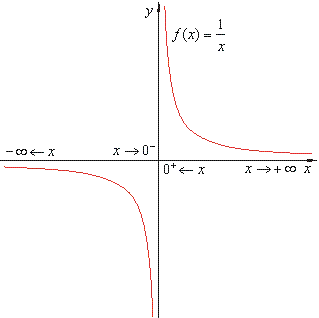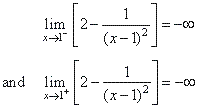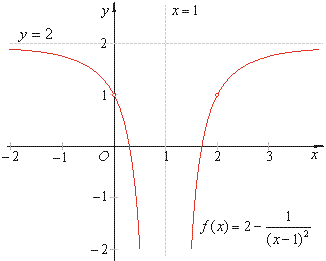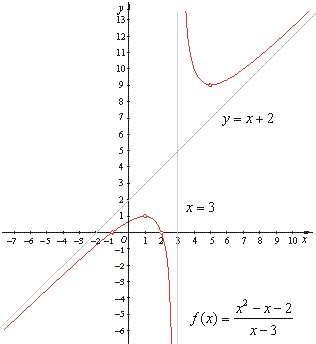|
Continuous
function
|
|
A
real function
y = f
(x)
is continuous at a point a
if it is defined at x =
a
and
|
 |
|
that
is, if for every e
> 0 there is a d
(e)
> 0 such that |
f
(x)
-
f
(a)
| < e
whenever | x
-
a | < d
(e).
|
|
Therefore,
if a function changes gradually as independent variable changes,
so that at every value a,
of the independent
variable, the difference between f
(x)
and f
(a)
approaches zero as x
approaches a.
|
| A
function is said to be continuous if it is continuous at all
points. |
|
|
Limits
at infinity (or limits of functions as x approaches
positive or negative infinity)
|
|
We
say that the limit of f
(x)
as x
approaches positive infinity is L
and write,
|
 |
|
if for any e
> 0 there exists N
> 0 such that
|
f
(x)
-
L | < e
for all x
> N
(e).
|
|
We
say that the limit of f
(x)
as x
approaches negative infinity is L
and write,
|
 |
|
if for any e
> 0 there exists N
> 0 such that
|
f
(x)
-
L | < e
for all x
< -N
(e).
|
|
Not
all functions have real limits as x
tends to plus or minus infinity.
|
|
Thus
for example, if f
(x)
tends to infinity as x
tends to infinity we write
|
 |
|
if
for every number N
> 0 there is a number M
> 0 such that f
(x)
> N whenever
x
> M
(N).
|
|
|
Infinite limits
|
| We
write |
 |
|
|
| if
f
(x) can
be made arbitrarily large by choosing x
sufficiently close
but not equal to a. |
| We
write |
 |
|
|
|
if
f
(x) can
be made arbitrarily large negative by choosing x
sufficiently close
but not equal to a.
|
|
|
The
limit of a function examples
|
|
Example:
Evaluate
the following limits,
|
|
|
 |
|
Solution:
a) As x
tends to minus infinity f
(x)
gets closer and closer to 0.
|
|
As x
tends to plus infinity f
(x)
gets closer and
closer to 0. Therefore,
|
 |
|
b)
As x
tends to 0 from the left f
(x)
gets larger in negative sense.
|
|
 |
|
|
As
x
tends to 0 from the right f
(x)
gets larger in positive sense. Therefore,
|
 |
|
|
Vertical, horizontal
and slant (or oblique) asymptotes
|
|
If
a point (x, y) moves
along a curve f
(x)
and then at least one of its coordinates tends to infinity,
while the distance between the point and a line tends to zero
then, the line is called the asymptote
of the curve. |
| Vertical
asymptote |
| If
there exists a number a
such that |
 |
|
| then
the line x
= a is the vertical
asymptote. |
| Horizontal
asymptote |
| If
there exists a number c
such that |
 |
|
| then
the line y
= c is the horizontal
asymptote. |
| Slant
or oblique asymptote |
| If
there exist limits |
 |
|
| then,
a line y = mx
+ c is the slant
asymptote of the function f
(x). |
| Example:
Find
the vertical and the horizontal asymptote
of the function |
 |
| Solution:
Since, |
 |
| then x
= 1 is the vertical asymptote. |
|
 |
|
| Since, |
 |
|
| then y
= 2 is the horizontal asymptote. |
| Example:
Calculate
asymptotes and sketch the graph of the function |
 |
|
| Solution:
By
equating the numerator with zero and solving for
x
we
find the x-intercepts, |
| x2
-
x -
2 = (x + 1)(x -
2) = 0, |
| x1
= -1
and
x2
= 2. |
| We
calculate f
(0)
to find the y-intercept, |
| f
(0)
= 2/3. |
| By
equating the denominator with zero and solving for
x
we find the vertical
asymptote, |
| x
= 3. |
| Let
calculate following limits |
 |
| to
find the slant asymptote y
= mx + c. |
|
 |
|
 |
 |
| Therefore,
the line y
= x + 2
is the slant asymptote of the given function. |
|
| Example:
Evaluate
the limit |
 |
|
| Solution: |
 |
|
|
| Example:
Evaluate
the limits, |
 |
|
|
|
|
|
Monotone
functions - increasing or decreasing in value
|
| 1.
The function is said to be increasing if
f
(x1)
< f
(x2)
for all x1
<
x2. |
| 2.
The function is said to be decreasing if
f
(x1)
> f
(x2)
for all x1
<
x2. |
| 3.
If
f
is either increasing or decreasing then
f
is said to be monotone. |
|